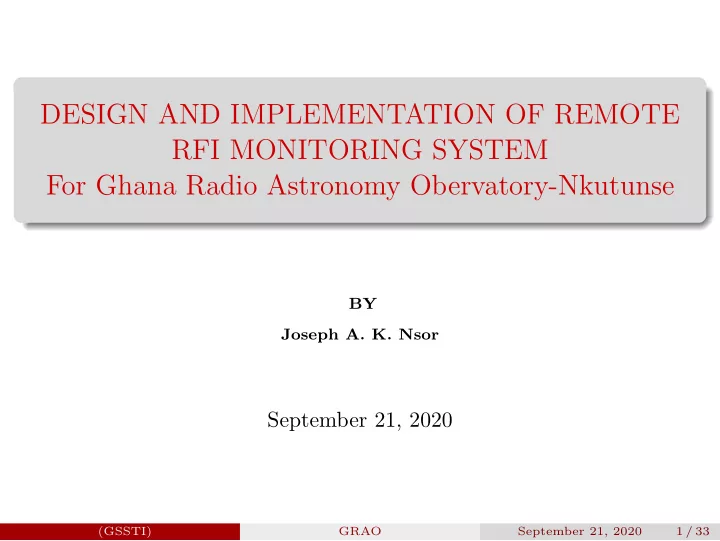

DESIGN AND IMPLEMENTATION OF REMOTE RFI MONITORING SYSTEM For Ghana Radio Astronomy Obervatory-Nkutunse BY Joseph A. K. Nsor September 21, 2020 (GSSTI) GRAO September 21, 2020 1 / 33
OUTLINE OF PRESENTATION 1 Abstract 2 Introduction 3 Internal Challenge 4 Objectives 5 Engineering 6 Results 7 Conclusion 8 Future Upgrade (GSSTI) GRAO September 21, 2020 2 / 33
Outline 1 Abstract 2 Introduction 3 Internal Challenge 4 Objectives 5 Engineering 6 Results 7 Conclusion 8 Future Upgrade (GSSTI) GRAO September 21, 2020 3 / 33
Abstract This work presents the design of an automated Radio Frequency Interference Monitoring System (RFIMS) for an informed data and future upgrades for interferences mitigation. Generally, the degradation of radio telescopes data is influenced by several factors that are due to the current environmental conditions.This requires an Investigation of Radio Frequency Interference (RFI) for the proposed telescope operation frequency by performing a site survey to gather information of the spectrum usage of the converted 32m class antennas into radio astronomy telescopes. Keywords : Radio Astronomy, LNA, Frequency Spectrum, Radio Frequency Interference, and Mitigation Techniques. (GSSTI) GRAO September 21, 2020 4 / 33
Outline 1 Abstract 2 Introduction 3 Internal Challenge 4 Objectives 5 Engineering 6 Results 7 Conclusion 8 Future Upgrade (GSSTI) GRAO September 21, 2020 5 / 33
History Figure 1: Ghana’s Decommission Satellite Dish (GSSTI) GRAO September 21, 2020 6 / 33
Global Issue Figure 2: World Network of Telescopes (GSSTI) GRAO September 21, 2020 7 / 33
Minus Ghana Figure 3: UV Coverage of The Milky Way Without Ghana (GSSTI) GRAO September 21, 2020 8 / 33
Plus Ghana Figure 4: Ghana’s Contribution to Viewing the Milky Way (GSSTI) GRAO September 21, 2020 9 / 33
Outline 1 Abstract 2 Introduction 3 Internal Challenge 4 Objectives 5 Engineering 6 Results 7 Conclusion 8 Future Upgrade (GSSTI) GRAO September 21, 2020 10 / 33
Evidence Figure 5: Conversion of Decommission Dishes into Telescopes (GSSTI) GRAO September 21, 2020 11 / 33
Environmental Factors Figure 6: Traditional Measurement Method (GSSTI) GRAO September 21, 2020 12 / 33
Outline 1 Abstract 2 Introduction 3 Internal Challenge 4 Objectives 5 Engineering 6 Results 7 Conclusion 8 Future Upgrade (GSSTI) GRAO September 21, 2020 13 / 33
Objectives This project undertaken is: To design and implement an automated RFI monitoring system. To determine the exact direction of an interfering signal. (GSSTI) GRAO September 21, 2020 14 / 33
Proposed Figure 7: Proposed Solution (GSSTI) GRAO September 21, 2020 15 / 33
Outline 1 Abstract 2 Introduction 3 Internal Challenge 4 Objectives 5 Engineering 6 Results 7 Conclusion 8 Future Upgrade (GSSTI) GRAO September 21, 2020 16 / 33
Polarization Subassembly (a) First Subsystem (GSSTI) GRAO September 21, 2020 17 / 33
Azimuth Subassembly (a) Second Subsystem (GSSTI) GRAO September 21, 2020 18 / 33
Complete Antenna System (a) Antenna System (GSSTI) GRAO September 21, 2020 19 / 33
Wire Configuration Figure 11: Wiring Layout (GSSTI) GRAO September 21, 2020 20 / 33
Step Parameters Step rev = 1 Rev (1) 360 1 . 8 =200 step Stepz rev For antenna polarization in E/H plane, its step angle is obtained by multiplying the step-rev to the number of micro stepping per revolution. And so in achieving 90 o angle for a full revolution, microstepping = 200 step rev 1 / 4 = 50 step P angle = (2) rev where (P-Angle) is Polarization angle. Considering the antenna pattern it is recommended that monitoring is done at an angle of 45 o for a full revolution of 360 o , with (A-angle) as the azimuth angle of rotation [70]. microstepping = 200 step rev 1 / 8 = 25 step A angle = (3) rev (GSSTI) GRAO September 21, 2020 21 / 33
User Interface Figure 12: Antenna Interface (GSSTI) GRAO September 21, 2020 22 / 33
Outline 1 Abstract 2 Introduction 3 Internal Challenge 4 Objectives 5 Engineering 6 Results 7 Conclusion 8 Future Upgrade (GSSTI) GRAO September 21, 2020 23 / 33
Preliminary Survey Measurement Platform. Cardinal Compass. (a) Azimuth Platform (b) Compass (GSSTI) GRAO September 21, 2020 24 / 33
Results Figure 14: Horizontal Polarization (GSSTI) GRAO September 21, 2020 25 / 33
Results Figure 15: Vertical Polarization (GSSTI) GRAO September 21, 2020 26 / 33
FAT Ref1 Figure 16: FAT for 5GHz (GSSTI) GRAO September 21, 2020 27 / 33
FAT Ref2 Figure 17: FAT for 6.7GHz (GSSTI) GRAO September 21, 2020 28 / 33
Outline 1 Abstract 2 Introduction 3 Internal Challenge 4 Objectives 5 Engineering 6 Results 7 Conclusion 8 Future Upgrade (GSSTI) GRAO September 21, 2020 29 / 33
Conclusion Figure 18: Complete RFIMS (GSSTI) GRAO September 21, 2020 30 / 33
Outline 1 Abstract 2 Introduction 3 Internal Challenge 4 Objectives 5 Engineering 6 Results 7 Conclusion 8 Future Upgrade (GSSTI) GRAO September 21, 2020 31 / 33
Upgrade To write an algorithm that the RFIMS can point to an interfering frequency of interest. (GSSTI) GRAO September 21, 2020 32 / 33
END OF PRESENTATION THANK YOU (GSSTI) GRAO September 21, 2020 33 / 33
Recommend
More recommend